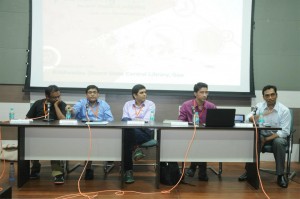This year, Publishing Next had just one panel discussion that purely concentrated on the technological aspects of publishing. Chaired by Brij Singh, co-founder of Fliplog, the panel sought to explore how new advancements in digital technologies could be incorporated to create a more involved experience for the reader. As such panels often do, this one too brought out the sharp differences between the “techie” (now almost used derisively) and the publisher communities. There emerged though a few important points:

a. Publishers seek solutions that are unique to their needs. This holds an important lesson for companies that provide e-publishing services because very rarely does one size fit all. Packaged services that are attractively marketed using colourful brochures by people who shy away from answering the tough questions do not cut it with publishers, especially with those that understand a little about e-book development and need to know it can make their books look more attractive.
b. Publishers need to educate themselves on the details of e-book development. This actually follows from the earlier point because many companies that provide e-book development services, unfortunately, gloss over the details and it becomes incumbent upon the publishers to ask the tough questions. Questions like: which formats are available? Where can they be viewed? Which are the preferred formats? What will my illustrations and fonts look like in the e-version? How closely will the layout match that of the printed version? Where can they be sold? How do I store and protect them?
c. Communication needs to be in a language that publishers understand. This is for the techies. It is important that the understand the terminology of book making and speak to publishers in a language that they (the publishers) are comfortable with. Very often, e-book development companies fill their brochures and other forms of communication with technical terms that obfuscate the details and, more often than not, put off the publisher. Terms like HTML5, SGML and XML mean little to the publisher. Instead it might help e-book developers if they learnt about widows, orphans and flyleaf pages. Total disregard for the book and its content and a pitch just based on technical capabilities is sure to lose an e-book developer its clients.
d. The pricing of services needs to be revisited. For publishers, this is a new game and, understandably, they are shy about wading into these waters. Given that the whole world is breathing down their neck and that they are told to develop e-books or perish, they have to make sense of the investments because the returns are yet unheard of. Companies that develop e-books must be aware of this and price their services rationally. Maybe a model that allows publishers a free first book so they can see what are the benefits? Or a discounted rate on the first book? Or a payment model that is based on commissions off sales? Companies need to be imaginative here.
e. Not all technologies are for all books. For example, fiction that is purely text have no need for development as enhanced books or apps. Technology companies should understand a publisher’s list and pitch their products accordingly. It is necessary for them to explain to the publishers the limitations of current technologies so that the expectations of publishers remain realistic. In the case of books in Indian languages, the limitations of reproducing certain fonts must be clarified before production of e-books is undertaken.
f. E-book development companies need to stand by what they deliver. Here it might be better for them to under-promise and over-deliver. This follows from the earlier point. Many companies have promised publishers the moon and have fallen far short of expectations. In many cases, unfortunately, this has resulted in publishers swearing off e-books altogether.
g. There is no platform yet, that is purely Indian, that caters to the sale of books. This becomes important when dealing with publishers of books in Indian languages. While Amazon has entered the Indian market, neither its reader, the Kindle, nor its e-commerce platform support Indian language books. It is therefore important to make publishers aware of this lack of a platform that might render their investments useless unless, of course, the e-books can be sold from their own website.
Suffice to say that much ground needs to be covered before a robust and sustainable environment around the development and sale of e-books is implemented. The publisher and developer communities need to work together towards the conception of such an environment and not insist on working in isolation.